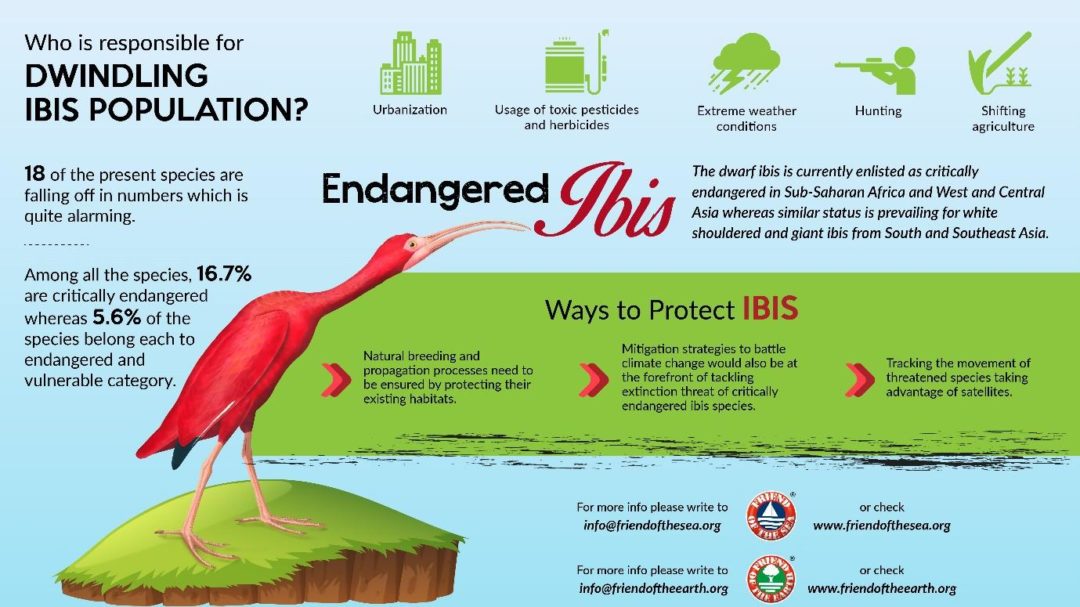The Problem
Ibis are birds with long legs and long-down curved bills which are used to explore mud for getting food. All the 42 extant species are aerial and they mostly live monogamous life. Majority of the species are found in terrestrial and freshwater habitats which accounts for 28.1% and 23.4% respectively while another 23.4% of the species are adapted to both terrestrial and freshwater habitats.
Various factors are contributing presently towards the deteriorating situation of ibis populations: hunting, trapping, logging and wood harvesting, gathering terrestrial plants.
Habitat degradation due to agricultural practices such as shifting agriculture, small-holder farming, agro-industry farming, livestock farming and ranching etc. are also contributing significantly towards this situation.
Human activities such as urbanization, industrialization, usage of toxic pesticides and herbicides, mining, recreational activities are forcing many of these species to shift their long-adapted habitats as they look to new places for food and propagation. Further threats come from invasive non-native or problematic native species and various pests and pathogens.

Environnemental consequences
The latest IUCN data shows that 18 of the present species are falling off in numbers. The Sub-Saharan African region tops among all regions, being the home of eight of these species. Likewise, Southeast Asia homes six species whereas there are five species from West and Central Asia and South America. Major areas of concern are countries like Cameroon, Congo, Ivory Coast, Ghana, Liberia, Madagascar, Sierra Leone, Vietnam, Thailand, Myanmar and Cambodia each of which harbor four of the endangered species.
Among all the species, 16.7% are critically endangered whereas 5.6% of the species belong each to endangered and vulnerable category. The dwarf ibis is currently enlisted as critically endangered in Sub-Saharan Africa and West and Central Asia whereas similar status is prevailing for white shouldered and giant ibis from South and Southeast Asia. A matter of regret is that few species became extinct already such as the Jamaican ibis or clubbed wing ibis.
Possible Solutions
Several steps need to be taken to conserve the critically endangered and endangered ibis species. First and foremost, natural breeding and propagation processes need to be ensured by protecting their existing habitats. In order to achieve that, strategies of industrialization, farming and urbanization should be adjusted appropriately, i.e., not undermining the habitats of these birds. Besides, habitat restoration activities such as effective management of national parks, wild life sanctuaries, protected in-land water bodies is crucial and such places need to be established in countries where such facilities are not available yet. A point to mention here is that the situation of northern bald species is improving consistently due to actions of conservationists in the Souss-Massa National Park, Morocco.
Ex-situ conservation practices such as captive breeding and artificial propagation could increase their numbers. Once success is achieved in this process, then these species could be reintroduced to their original habitats or new habitats. The crested ibis lately made a comeback to South Korea 40 years after becoming extinct due to successful captive breeding programs. Relevant scientific community has a huge role to play in this regard. Nowadays, tracking the movement of threatened species taking advantage of satellites is possible and these should be done for ibis as well. They should also design experiments to understand the breeding practice of these birds and to find solution against various alien species and pathogenic diseases.
WSO’s activities and initiatives
WSO has taken the following steps as part of its ongoing activity towards certifying products generated from sustainable aquaculture and agriculture:
- Launch a Change.org campaign to save the following Critically endangered Ibis:
- The White-shouldered Ibis in Cambodia, Indonesia, Lao People’s Democratic Republic;
- The Dwarf Ibis of Sao Tome and Principe.
- The Giant Ibis in Cambodia, Lao People’s Democratic Republic and Vietnam
- Communicate with key politicians, industrial bodies, agricultural and aquaculture business owners as well as farmers to notify them about their social responsibilities and act accordingly to protect critically endangered ibis species.
- Organize or participate in various seminar, symposium, conferences to raise awareness among the local communities so that they become educated about these birds and carry out vigilance against illegal hunting and trading of ibis.
Call to action
- Sign WSO Change.org Save the Ibis campaign
- Elect politicians who are committed to environmental sustainability, e.g., saving threatened ibis species by introducing new laws and activities. For instance, the giant Ibis is a national bird of Combodia. The Government is waking up to a call to save these birds by introducing a 10-year action plan.
- Establish ex-situ conservation facilities and new national conservation park and in-land water area in countries where it is not available yet.
- Purchase products which are Friend of the Earth certified.
- Increase funding for search on conservation of various threatened ibis species.










